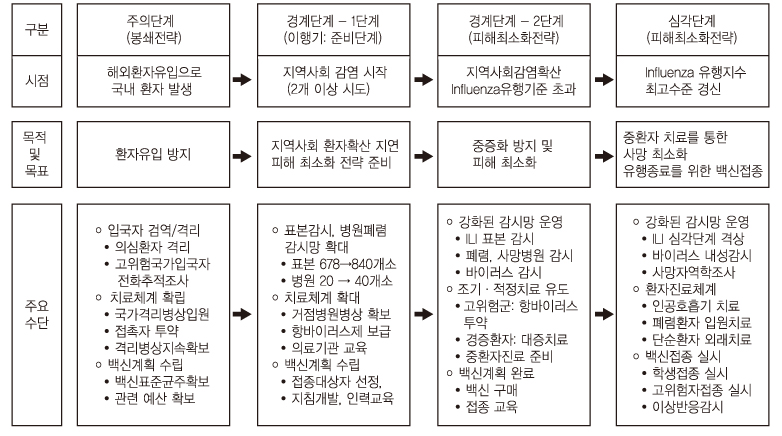 |
 |
- Search
| J Korean Med Assoc > Volume 53(1); 2010 > Article |
Abstract
The alert regarding the emergence of novel influenza was issued by the WHO on April 24th, and the government has taken immediate actions to respond to the situation since then. Based on the presumption that a pandemic was imminent, countermeasures for the H1N1 influenza pandemic have been prepared by establishing and implementing effective public health crisis strategies over the past few years. Our main strategy during the pandemic influenza crisis has shifted in accord with the corresponding National Disaster Phases. In the Caution (Containment) Phase, our main goal was to contain the influx of disease from overseas. We focused on measures such as entry screening and quarantine inspection while monitoring travelers arriving from affected countries. In the Alert Phase I, our aim was deceleration and prevention of secondary community outbreaks through enhanced early detection. We intensified our surveillance and response system for possible mass outbreaks. During Alert Phase II, as the influenza had spread widely, our tactics switched to minimizing social and economic impact and preventing severe cases with early administration of antiviral agents, especially among high-risk patients. In the current Severe Phase, we are trying to reduce mortality cases with intensive care. Since we have implemented mass vaccination, we predict an early termination of the pandemic.
References
1. World now at the start of 2009 influenza pandemic. WHO 2009;07. 11. (http://www.who.int/mediacentre/news/statements/2009/h1n1_pandemic_phase6_20090611/en/index.html)
2. Pandemic(H1N1)2009-update76. WHO 2009;11. 27. (http://www.who.int/csr/don/2009_11_27a/en/index.html)
3. Case of Novel Influenza A(H1N1) Infection in the Republic of Korea. Public Health Wkly Rep 2009;2:293-295.
4. Three fatal cases due to Novel Influenza A(H1N1) Infection. Public Health Wkly Rep 2009;2:624-625.
5. Current status of selected infectious diseases. Public Health Wkly Rep 2009;2:594.
6. Current status of selected infectious diseases. Public Health Wkly Rep 2009;2:778.
7. Korea Centers for Disease Control and Prevention. Pathogen Lab Surveillance Report. Weekly Acute Infectious Disease Pathogen Surveillance. Acute Respiratory Virus Week 45.
8. Korea Centers for Disease Control and Prevention. Internal Report.
9. Avian Influenza: assessing the pandemic threat 2005;World Health Organization.
10. Cumulative number of confirmed human cases of avian influenza A(H5N1) reported to WHO. WHO 2009;09. 24. (http://www.who.int/csr/disease/avain_influenza/country/cases_table_2009_09_24_en/index.html)
11. The Possibility and Strategies against Pandemic Influenza. J Korean Med Assoc 2005;09.
12. WHO Global Influenza Preparedness Plan: The Role of WHO and Recommendations for National Measures before and during Pandemic 2005.
- TOOLS
-
METRICS

-
Related articles in
J Korean Med Assoc -
Measures against Pediatric Metabolic Syndrome2010 May;53(5)
Countermeasures of violence against medical staff2014 February;57(2)








